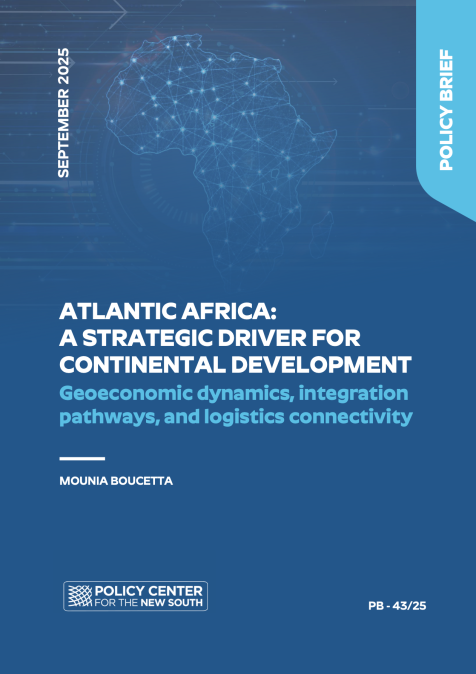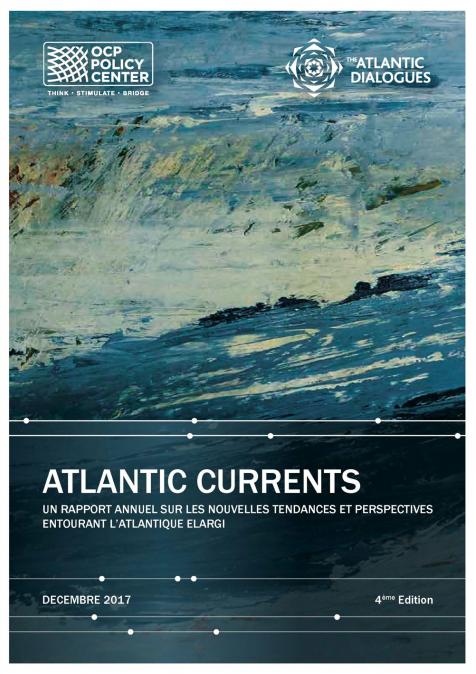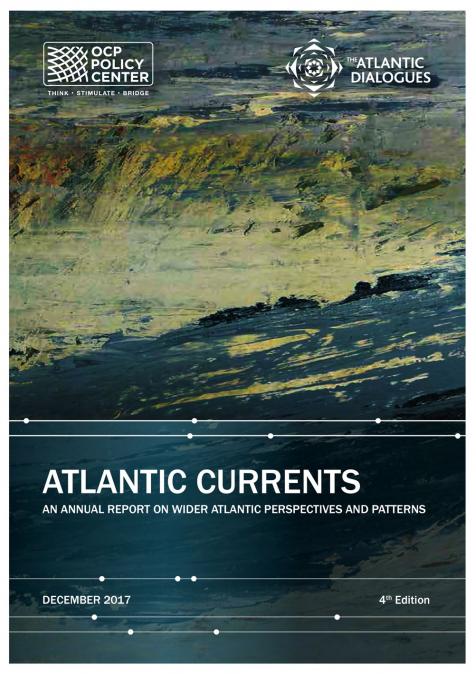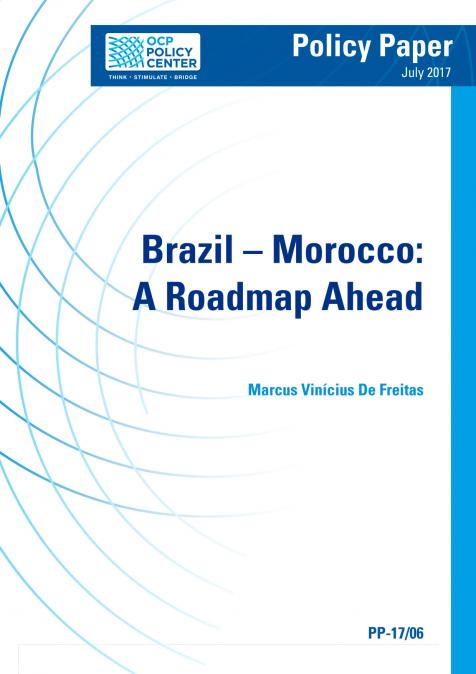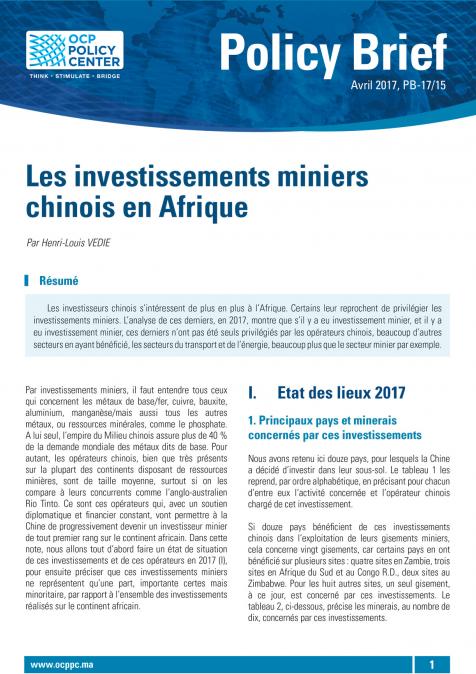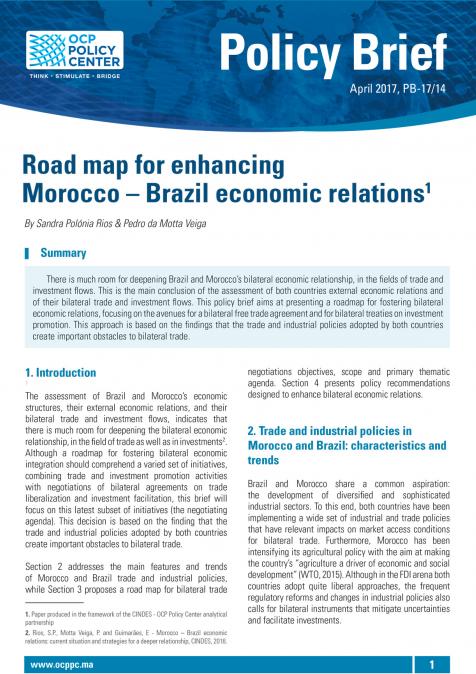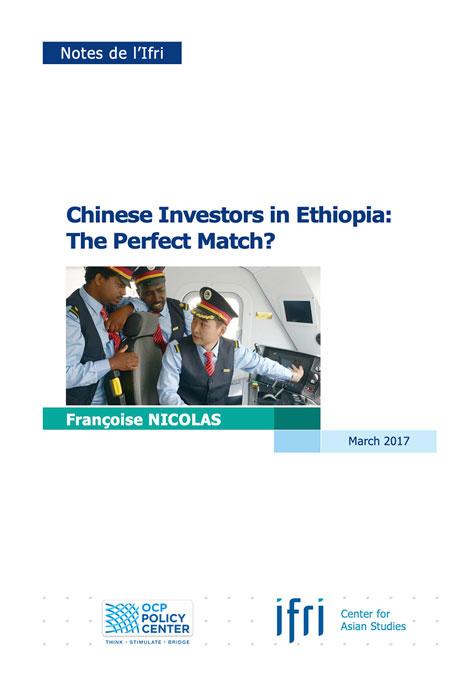Publications /
Policy Brief
Africa's development depends on the mobilization of catalytic levers capable of accelerating growth momentum, with wider benefits for the African people. The digital, energy and demographic transitions are all major challenges, but at the same time they present the continent with new opportunities for transformation. In this context, Atlantic Africa appears to be a strategic and promising area, thanks to the richness and diversity of its natural resources, its geographical position and the growing interest it is arousing among various international players. The central issue is to determine how this space can play a role as a driver of transformation, leveraging these transitions while considering the economic dynamics within the Atlantic basin, the regional integration strategies of riparian countries, as well as security and geo-economic issues.
INTRODUCTION
Africa is making progress, but its advances remain limited, with a pace insufficient to achieve the Sustainable Development Goals (SDGs) by 2030, or even to realize the "Agenda 2063: the Africa we want", adopted by the African Union in 2015. This uneven and unsustainable progress is largely due to persistent vulnerability to multiple crises, both internal and external. These structural fragilities are reflected in development indicators that are still alarming in several regions, with a risk of further deterioration due to the decline in international aid, following the European budget cuts in 2021 and the Trump administration's decisions in 2025. Indeed, in a context where exposure to risk remains high for many African countries the reduction in aid limits their capacity to mobilize the financing needed for development projects.The global geo-economic context, combined with Africa's own challenges, calls for an in-depth rethinking of the development levers mobilized so far, in order to identify those that are truly capable of supporting the continent's growth. This strategic reconfiguration requires enlightened choices in terms of priorities, solutions, technologies and partnerships. Africa needs catalytic and transformative levers capable of accelerating its progress in a sustainable manner, supporting the deployment of structural reforms, and generating multiplier effects benefiting different regions and all social strata. The continent's specific characteristics should guide the identification of the levers most likely to produce the desired effects, without necessarily following existing or predefined paths.
Undoubtedly, regional as well as continental economic integration remains an essential lever, since today's challenges cannot be met by one country acting in isolation, and certain investments are only viable on a regional scale. New models of cooperation are needed to avoid the difficulties experienced by Africa's Regional Economic Communities (RECs), and to remedy shortcomings in resource mobilization and governance. Although these communities have made some progress, they have also shown their limitations, whether in terms of institutional blockages or low levels of economic cooperation. In the same vein, the African Continental Free Trade Area (AfCFTA) presents a very promising model for economic integration. Its success will depend not only on its ability to stimulate intra-African trade, but above all on its contribution to building competitive regional value chains and fostering new economic opportunities on a continental scale. Similarly, maritime areas can be powerful vectors of economic integration particularly for riparian countries. By strengthening their cooperation, they can develop efficient logistics hubs and improve their integration into global value chains.
Furthermore, the continent's development requires profound and lasting transformations. Increasing investment in essential, strategic sectors such as energy, water, food systems, health, industry, and logistics is indeed a key condition for achieving many SDGs. However, how can this be achieved when many African countries already face debt levels close to, or even above, critical thresholds, while access to concessional financing is shrinking, multilateral development banks highlight
structural weaknesses in governance, and the continent's attractiveness for foreign direct investment remains limited, at only 2 to 3% of global flows?
Accelerating development in Africa requires strategic deployment of investments. The projects pursued should be part of a long-term vision, aligned with the ambition for greater economic integration of the continent. Innovation, whether at the design, financial structuring or implementation stages, is an essential lever capable of generating lasting positive externalities and mobilizing private investment. Examples include major transnational infrastructure projects designed to stimulate logistic, energy or digital synergies between African countries. Other type of initiatives could involve the creation of industrial or technological clusters, promoting the local transformation of natural resources and their integration into regional and global value chains.
From this point of view, the African Atlantic axis represents a geographic integration vector that is still largely under-exploited, but with great potential for transformation. It could become a successful model for regional integration, drawing on key geostrategic advantages: proximity to dynamic European and American markets, anchorage on the world's major shipping routes and a wealth of diversified natural resources. Transforming these advantages into concrete levers for development and economic integration, on both a regional and continental scale, requires a strong political will, targeted investments and coordinated governance between riparian countries.
This analysis explores the economic potential of Atlantic Africa and the role it can play in the continent's development, considering the economic dynamics and regional integration approaches adopted by the countries bordering the Atlantic basin, their logistics environment, security issues influencing trade and investment, and new geo-economic realignments.
THE GEOECONOMIC DIMENSION OF THE NORTH ATLANTIC-AREA
The Atlantic Basin is characterized by multiple and contrasting dynamics, marked by strong disparities between its northern and southern shores. Nevertheless, it remains one of the world's most strategic maritime areas, not only because of the intensity of its trade, energy and logistics flows, but also because it currently appears to be relatively unaffected by certain risks that undermine other maritime regions. While military tensions, blockades, naval accidents, navigational restrictions, and drone or missile attacks are on the increase elsewhere, the Atlantic Ocean has, for now, maintained a valuable degree of stability, with the exception of the Gulf of Guinea, which is experiencing relatively significant episodes of piracy and maritime crime. Whereas the North Atlantic was at the heart of Cold War rivalries, the South Atlantic has long been regarded as an area to be preserved. In 1986, the UN proclaimed the "Zone of Peace and Cooperation of the South Atlantic" (ZPCAS), bringing together African and South American countries, with the aim of keeping this area free from conflict, foreign military bases and nuclear weapons.
The current geo-economic and security realities of this basin reveal three zones with distinct characteristics. The North Atlantic links the nations of Western Europe (the European Atlantic seaboard) with the United States and Canada. This is the historic heartland of transatlantic cooperation, characterized by a high level of institutionalized cooperation, notably through the North Atlantic Treaty Organization (NATO). This area is the main logistical axis for any American reinforcements in Europe in the event of a crisis and is patrolled by nuclear-powered ballistic missile submarines (SSBNs), with a large fleet of ships and aircraft carriers to reinforce maritime security. Despite NATO's military and technological capabilities, this region is experiencing the emergence of threats of attack and sabotage against submarine cables, particularly those linked to the Baltic Sea, one of the most exposed regions in recent years. The area is also marked by drug trafficking from Latin America to Europe via the North Atlantic, as well as irregular migration via the Caribbean Sea route to the United States, or the route linking West Africa to the Canary Islands.
In economic terms, the North Atlantic Basin is one of the most dynamic regions, even thoughit only accounts for around 14% of global container traffic, behind Transpacific and Asia-Europe flows. However, it remains a strategic area and a major energy reservoir, thanks to oil and gas flows from the United States, which has become the world's leading producer in this sector and Europe's leading supplier of liquefied natural gas (LNG) since the start of the Russian-Ukrainian conflict.
This region is also home to the development of large-scale transnational projects, such as the Atlantic European Transport Corridor (ETC), which is currently being deployed. The project aims to connect several European countries, including Portugal, Spain, France, Germany, and Ireland, by rail, road, river, and sea. Ultimately, it will serve 25 ports, 27 rail-road terminals, and 59 urban nodes. At the same time, other energy interconnection initiatives between North America and Western Europe are being studied, exploring possibilities to strengthen North Atlantic energy security. The rapid development of digital infrastructure is also noteworthy, particularly the deployment of submarine fiber optic networks, mainly driven by private operators such as Google, Meta, and Microsoft.
In 2023, the United States (US) launched the "Partnership for Atlantic Cooperation" (PAC), bringing together 32 countries from Europe, Africa and the Americas to go beyond the traditional US-Europe transatlantic axis and further integrate Africa and Latin America into its global strategy. This cooperation framework aimed to address a wide range of issues, from economic development to environmental protection, science and technology, including sustainable ocean economy, resource management and the fight against illegal fishing and trafficking. According to a White House press release dated September 23, 2024, , 42 countries have joined the PAC since its launch, representing 75% of the Atlantic coastline. With the arrival of the Trump administration, the future of this partnership now appears uncertain, in a complex geopolitical context marked by a more transactional American approach focused on national interests. Control of key maritime zones, strategic economic infrastructure and critical natural resources remains high on the agenda.
THE LATIN ATLANTIC SPACE: REGIONAL INTEGRATION, COOPERATION AND SECURITY
In the southern part of the Atlantic Basin, two main geographical areas can be distinguished: the Atlantic seaboard of Latin America and the Caribbean, and the Atlantic seaboard of Africa. The Latin American zone comprises the countries of Latin America and the Caribbean with an Atlantic coastline, in particular the countries bordering the Gulf of Mexico, the states of eastern Central America and the Caribbean islands, as well as the countries on the Atlantic coast of South America, stretching from Venezuela to Argentina. This area is characterized by diverse regional dynamics, reflected by varying degrees of political and economic cooperation. It encompasses major regional powers, such as Brazil, ranked between the ninth and tenth largest economies worldwide in recent years, as well as the relatively economically vulnerable, but strategically well-positioned, island states of the Caribbean. According to the United Nations Conference on Trade and Development (UNCTAD), Latin America’s share of containerized flows is relatively low, around 7% of the global total, and is largely driven by the Atlantic seaboard through its main transshipment hubs (Colón, Kingston, Caucedo, Montevideo) and major export ports (Santos, Buenos Aires).MERCOSUR (Southern Common Market) is often regarded as an incomplete model of economic and commercial integration, bringing together Brazil, Argentina, Uruguay and Paraguay. In a similar vein, the countries of Central America have set up the Central American Integration System (SICA), which includes Guatemala, Nicaragua, Honduras and Costa Rica, based on economic and political cooperation, albeit sometimes undermined by institutional instability and internal tensions. For their part, the Caribbean states have also set up regional organizations, such as CARICOM (Caribbean Community), aimed at regional economic integration, but whose dynamism remains hampered by structural constraints due to the group's low economic weight and the application of protectionist measures.
Despite the existence of several economic cooperation frameworks, the region's maritime trade flows are still mainly directed towards North America, Asia and Europe. Inter-regional trade in Latin America remains limited, accounting for around 16% of total flows. Over the past few decades, China has established itself as a central economic player, importing massive quantities of natural resources, particularly from the South American Atlantic (iron ore, copper, soybeans, oil), and investing in the region's logistics and energy infrastructure. For example, China has full or partial ownership of hundreds of power plants in Brazil, representing close to 10% of the country's electricity production capacity. Its largest deep-space tracking station outside China is located, in Argentina. More recently, China has refocused its investments on targeted strategic sectors such as electric mobility, renewable energies, telecommunications and digital technology. As a result, China has become South America's leading trading partner, and second only to the USA in Latin America as a whole.
Latin America's Atlantic seaboard remains historically and economically preeminent within the continent, concentrating the main industrial hubs,demographic centers and logistics infrastructure, particularly in Brazil, Argentina, and Uruguay. Latin American countries, including those bordering the Atlantic, are seeking to position themselves as strategic platforms connecting the Atlantic and Pacific, as well as Northern and Southern markets. The development of logistical corridors has long been a central focus of these countries' economic policies. Nevertheless, the region's infrastructure still requires substantial investment to enhance its competitiveness and performance on a global scale.
Among the most important logistics infrastructure is the Hidrovía Paraná-Paraguay river corridor, over 3,400 km long, which crosses five countries (Brazil, Argentina, Paraguay, Bolivia, and Uruguay) and connects to the Atlantic Ocean. This corridor provides maritime access for Paraguay and Bolivia. It is operational, but requires regular dredging and maintenance work to remove navigation constraints at certain points. There are also a number of land-based logistics corridors, connecting hubs or multimodal areas by rail or road. However, these corridors are sometimes perceived not as instruments of complementarity between local economies, but rather as vectors of competition. This sometimes leads certain countries to seek strictly national benefits, to the detriment of regional integration dynamics.
The South Atlantic Corridor (Corredor Bioceánico Vial) is a road megaproject of over 2,400 km, designed to link Campo Grande in Brazil to the northern Chilean ports of Antofagasta, Iquique and Mejillones, crossing Paraguay and Argentina. Currently under development, its inauguration is scheduled for 2026. The project aims to significantly reduce logistics costs and capture up to 40% of the goods traffic currently carried via the Panama Canal. At the same time, other initiatives are being launched to strengthen interconnections between the continent's Atlantic and Pacific coasts, through new bi-oceanic corridors. These include a 4,000 km rail link between the port of Santos in Brazil and Ilo in Peru. These links should not only facilitate trade with Asia, but also contribute to the development of transpacific trade by diversifying continental logistics routes.
Another area that could strengthen regional integration in Latin America is the green energy transition. One of the most promising developments in this area is associated with green or low-carbon hydrogen. Indeed, the regional portfolio includes more than 160 projects at various stages of design and implementation. According to estimates by the Latin American Energy Organization (Olade), these projects would require investments of around 300 billion USD by 2050. For its part, H2 Chile (Chilean Hydrogen Association), a non-profit organization that brings together the main players in Chile's hydrogen industry, has announced the development of 75 hydrogen projects in Chile, with14 pilot projects already underway and 70% of which concern the mobility sector. At the same time, similar initiatives are being studied or launched in Brazil and Argentina.
The emergence of such an ecosystem implies the development of cross-border infrastructures, including pipelines for the transport and distribution of hydrogen, as well as electricity grids powered by renewable energies. The region should be able to attract more foreign investment and create more favorable financing conditions to bring its program to fruition. A number of hurdles remain, however, including the complexity of the infrastructure to be deployed, the need for a stable and appropriate regulatory framework, and the management of financing costs and risks associated with innovative projects.
Finally, despite the political will demonstrated by Latin American groupings to strengthen regional economic integration, many obstacles persist. These include the lack of high-performance logistics platforms, geographical constraints, tariff barriers, and major economic asymmetries between partner countries. These structural difficulties are compounded by illicit drug trafficking, a veritable scourge that undermines national economies. This phenomenon increases logistical costs and delays, while making cross-border payments more complicated and more expensive. Deeply rooted in the Latin American Atlantic area, this traffic enables a significant proportion of the cocaine produced in the Andean region to transit along the maritime routes of the Caribbean Sea and the South Atlantic. This flow often passes through West Africa before reaching Europe. Maritime surveillance capabilities, however, remain very unequal from one country to another: while Brazil and Argentina have relatively well-developed naval forces, many Caribbean and Central American states remain severely under-equipped to deal with maritime drug trafficking, due to insufficient material resources and capabilities.
MAKING ATLANTIC AFRICA AS A DRIVER OF CONTINENTAL DEVELOPMENT
The challenges of sustainable development on the continent highlight the urgent need for African countries to act collectively, though with new approaches. Indeed, all the indicators converge toward a worrying observation: efforts to date have fallen far short of the targets set, whether in terms of inclusive economic growth, social justice or environmental sustainability. In this already highly complex context, three major transitions - digital, demographic and energy - will further disrupt global trends for both developed and less advanced countries. Depending on the approach adopted, they could either accentuate the continent's current vulnerabilities, or on the contrary constitute decisive levers for accelerating its development.The digital transition, marked by the emergence of disruptive technologies such as the Internet of Things (IoT), artificial intelligence, and blockchain, is reshaping production, governance, and communication relationships. This transformation calls for rapid adaptation of public policies, education, and digital ecosystems for data production and exploitation, or risks accentuating digital and social divides. Similarly, Africa's demographic transition represents both a challenge and an opportunity. If well managed, this dynamic could serve as a powerful lever for endogenous growth, innovation, and talent renewal, given the weight of the young population. Conversely, without appropriate policies, it risks fueling unemployment and irregular migration. The energy transition is reshaping traditional geopolitical balances, redistributing power around new energy sources, critical raw materials, and green technologies. Countries capable of mastering these new value chains could increase their capacity to exert influence and resilience on the international stage. The energy transition is reshaping traditional geopolitical balances, redistributing power around new energy sources, critical raw materials, and green technologies. Countries capable of mastering these new value chains could increase their capacity to exert greater influence and enhance their resilience.
In addition, sovereignty issues are taking on an increasingly central role. They are no longer confined to traditional areas such as food security or health, but are now extending to highly strategic sectors such as digital technologies, data, energy, and critical minerals. This sovereignty, which is being sought at several levels, calls for a redefinition of models of action and new cooperation frameworks between African countries, and more generally at the international level. Indeed, many structuring projects, particularly in the fields of energy transition, transport, and logistics, cannot succeed without close cooperation between African states, especially neighboring ones. The interconnection of networks and infrastructures, as well as the development of cross-border projects, creates favorable conditions to guarantee the economic viability of investments, as well as their sustainability.
Several African regions have significant energy, fishing, mineral and agricultural resources; however, their development remains very limited, with exports generally in the raw form. The significant infrastructure deficit, compounded by the low level of regional interconnection needed to optimize logistics costs, as well as limited access to competitive electricity, hampers the attractiveness of investment in industrial processing projects. This is particularly true of Atlantic Africa, which is rich in natural resources, but marked by wide disparities in terms of development and access to electricity: while the electrification rate in Morocco and Cabo Verde exceeds 90%, it is barely 30% in Liberia and Sierra Leone.
Yet investment in cross-border, interconnected projects could produce significant catalytic effects, both for the region and for the continent as a whole. Africa's Atlantic seaboard enjoys a favorable geostrategic position; situated at the heart of a basin undergoing profound change, it is driven both by the growth of North Atlantic dynamics and by the transformations underway in the South Atlantic. These developments open up promising prospects for more sustained and integrated growth in the years ahead. The World Bank estimates that economic activity in the Atlantic Ocean already generates nearly 1.5 trillion USD per year, a volume set to double by 2030.
Moreover, the 23 African countries bordering the Atlantic, from Morocco to South Africa, account for around 55% of the continent's GDP and 46% of its population. Any transformation initiative in this area would have a multiplier effect: it would strengthen the regional dynamics, while producing positive benefits for the entire African continent.
In 2022, Morocco launched the Atlantic African States Process (AASP), designed to create a space for consultation and cooperation between the countries of this region, in order to strengthen security, stability and prosperity. Since then, annual ministerial meetings have been held on a regular basis, most recently in Praia in May 2025. In the same context, the Atlantic Africa Initiative, launched by His Majesty King Mohammed VI in his speech on the 48th anniversary of the Green March in November 2023, stands out for the relevance of its strategic scope. While emphasizing the importance of cooperation between the 23 Atlantic African states, this initiative aims to open up the Sahel countries by upgrading their infrastructure and connecting them to regional transport and communications networks, in order to facilitate their access to the Atlantic.
One of the projects that perfectly illustrates the spirit of this initiative is the Nigeria-Morocco gas pipeline, also known as the Africa-Atlantic Gas Pipeline, launched in 2016 by His Majesty King
Mohammed VI and President Muhammadu Buhari. This major project will connect Nigeria to Morocco along the Atlantic coast and through13 West African countries, over an estimated length of some 6,800 kilometers, with the potential to supply gas to landlocked Sahelian countries. Ultimately, the pipeline is expected to transport some 30 billion cubic meters of natural gas per year, a significant proportion of which could be exported to Europe.
By connecting gas-producing, exporting and importing countries, this unifying project aims to support the region's economic and social development. It aims to improve access to energy for several importing countries, which could boost their economic activity and help improve social conditions for their populations. At the same time, the strengthening of gas infrastructures will enable several countries to increase their export capacities while reducing their logistical costs. Currently at an advanced stage of study, the project will be implemented in phases, the first of which is scheduled for 2029.
The Africa-Atlantic Gas Pipeline is an example of an energy integration model that can be deployed in other sectors to drive a genuine energy transition in the region. Drawing on its large gas reserves and abundant natural resources, including water resources and vast coastal areas suitable for solar, wind and green or low-carbon hydrogen production, Atlantic Africa is well positioned to host diversified energy corridors (gas, renewables and low-carbon). These corridors would foster the emergence of an integrated network of energy hubs, interconnected by modern infrastructure such as gas pipelines, power grids and port facilities. Such hubs would not only help secure regional supplies of clean, low-carbon energy, but also meet part of European demand.
This plan is fully in line with the new transformations in the global port landscape. The spread of containerization has led to increased terminal specialization and the gradual extension of port infrastructure. Against this backdrop, vast integrated logistics zones are emerging around ports, reinforcing synergies between port hubs and major continental corridors. At the same time, the energy transition in the maritime sector is creating new imperatives: the need for supply hubs for synthetic fuels (e-fuels) and the green electrification of quaysides. These developments are designed to meet the target set by the International Maritime Organization (IMO) of reducing shipping emissions by at least 50% by 2050, compared with 2008 levels, a target since revised toward achieving net-zero emissions by around the same horizon.
These energy and logistics dynamics open up interesting prospects for the repositioning of Atlantic Africa, based on structural transformations and targeted investments. The strengthening of logistics interconnections, power grids and digital cables is crucial, as is support for the emergence of new industrial, logistics and service sectors to fully capitalize on these developments. The aim is to develop competitive regional platforms, fully integrated into global value chains, within the framework of a shared vision supported by the African countries concerned and translated into effective cooperation and governance mechanisms.
ATLANTIC AFRICA AND THE NEW GEO-ECONOMIC RECONFIGURATIONS
The African side of the Atlantic Basin, like the Latin American side, is attracting growing interest and becoming an area of recomposition of economic power dynamics. This trend is accompanied by the rise of new non-African players, led by China, the United Arab Emirates, Russia and Turkey. Against a backdrop of heightened geo-economic competition, the initiatives taken by these countries focus primarily on trade, natural resources and infrastructure.
Despite the intensification of these new actors’ presences, European countries and the USA remain important economic partners for the African states bordering the Atlantic. Trade is still largely dominated by exports of hydrocarbons (oil and gas), minerals (iron, bauxite, gold, copper, etc.), agricultural products and a few manufactured goods, notably from South Africa, Morocco and Nigeria. At the same time, China is gradually expanding its footprint, establishing itself as the leading trading partner of major African Atlantic economies, in particular Nigeria and South Africa.
Taking these new trends into account, the European Union is seeking to preserve its historic relationship, by launching its "Global Gateway" strategy covering the period 2021-2027, with an investment envelope of EUR 150 billion earmarked for Africa to finance projects in green energy, digital, transport infrastructure, health and education. At the halfway stage, 26 projects have been identified, many of them in the climate and energy sectors. These projects are also designed to open up new opportunities for the European private sector in Africa. For its part, the USA has reoriented its mode of intervention in Africa. In 2025, US initiatives led by President Trump have focused more on a transactional trade partnership, around natural resources and strategic investments, while reducing conventional development aid and adopting protectionist measures to support US industry.
In this context, African ports play a key role in boosting trade. Tanger Med is one of the continent's most advanced and largest ports in terms of container traffic, with a capacity of 9 million TEUs (twenty-foot equivalent units). Ranked 17th worldwide in 2024, according to Alphaliner, it handled 10.24 million TEUs that year, recording growth of over 18.8% on the previous year. In the West African sub-region, the main ports are Lagos (Nigeria), Abidjan (Côte d'Ivoire), Dakar (Senegal) and Douala (Cameroon), accounting for around 30% of regional port traffic. In addition, Durban (South Africa) is one of the continent's busiest ports, thanks to its strategic position on a major global trade route. Although located on the Indian Ocean, Durban is also connected to Atlantic trade flows via the Cape of Good Hope shipping route, reinforcing its role in inter-oceanic trade. New port projects are currently under development, such as the Dakhla Atlantique port in Morocco, the Ndayane port in Senegal and the Barra do Dande port in Angola, which should reinforce the region's logistics capacities and increase the volume of trade flows.
These ports are of central interest, as they are both upstream and downstream of logistics corridors. As a result, they are coveted by a number of countries with commercial, political and military interests. Since China's launch of the Belt and Road initiative (BRI) in 2013, its priorities in Africa have focused on these facilities, maintaining a military and logistical presence at certain naval bases. China has established itself as the leading foreign financing partner, with more port projects in Africa than in Latin America or Asia. China is involved in over thirty ports along the Atlantic seaboard. The role of Chinese entities varies by the project: builder, operator, concession holder or mere financier. Only five ports have been built through direct Chinese investment, mainly in Guinea, Nigeria, Côte d'Ivoire, Cameroon and Sierra Leone. China is seeking to secure its supplies of hydrocarbons and minerals, while consolidating its control of logistics chains and maritime routes. After the downturn in its financial commitments in 2017, caused by the slowdown in its economy and the rising debt levels of several African countries, Beijing has renewed its interventions on the continent since 2023. This resumption is characterized by an improvement in the quality of investments, diversification into new sectors such as digital, fintech, agritech and e-commerce, and greater involvement of the Chinese private sector. It is also reflected in a refocusing on smaller but better-targeted projects with a positive environmental impact, promoting the spread of the green technological solutions developed in China.
The United Arab Emirates (UAE) has also increased its investments in Africa in recent years, taking advantage of the period when China began to reduce its commitments to the continent between 2019 and 2023. The UAE is more present in East Africa, and in Atlantic Africa, its motivations are to control strategic sites in the Atlantic Ocean and strengthen its global logistics role. It is involved in port management in Senegal and Angola, and are currently working on a project in Congo.
Since 2010, Russia has stepped up its trade with Africa, focusing primarily on the strategic arms and energy sectors, which directly involve the main players in the Russian and African regimes. At the same time, Russian companies have invested in the extractive industries, notably mining, oil and gas, as well as in the associated infrastructure, to facilitate the transport and export of these resources. The imposition of Western sanctions, however, has led to a decline in Russian activities on the continent and the withdrawal of certain projects. Nevertheless, Moscow's economic interest in Africa has not waned, and Russia is now seeking to redeploy along new lines, in particular the development of port projects, such as those planned in Lagos and Dakar. Among the projects announced for 2025 is the launch of a direct maritime link between Novorossiysk and Lagos, designed to provide new outlets for Russian exports. Finally, while Russian investment has fallen back overall, oil trade between Russia and sub-Saharan Africa has risen. This dynamism can be explained by the price ceilings imposed by Western sanctions, which have enabled Russia to gain market share in Africa.
Turkey is following a different logic, multiplying its interventions via concessions or public-private partnerships (PPP) in the airport and public facilities sectors, thus strengthening the presence of its private companies in Senegal, Guinea and Togo. India is also expanding its trade and investments, especially in Nigeria, Ghana and Senegal, in the hydrocarbons, agribusiness, and pharmaceutical industries, as well as in the field of information technology, while strengthening its commercial and security partnerships with regional organizations.
Alongside governments, foreign private operators such as MSC, Maersk and CMA CGM play an important role in Atlantic Africa, with specific economic and geostrategic ambitions and influences. While these investments contribute to the integration of global markets and the upgrading of infrastructure, they also raise questions of economic sovereignty and sustainability, particularly regarding the control of strategic assets, the development of local content, respect for contractual transparency and environmental and social standards, and the long-term viability of infrastructure.
On the other hand, the maritime potential of the Atlantic seaboard is threatened by security risks, such as piracy, illicit trafficking and coastal instability, which hamper investment and accentuate the marginalization of certain territories. Indeed, political instability in certain West and Central African states, combined with the activities of armed jihadist groups in the Sahelian strip, creates a breeding ground for the networks of traffickers exploiting this region. For example, the Gulf of Guinea (from Senegal to Angola) has been the world's main maritime piracy zone for the past decade, with dozens of acts of piracy, oil cargo thefts and kidnappings every year, particularly off the coasts of Nigeria, Benin, Togo and the region. This situation is all the more worrying as current security initiatives remain scattered, limited in scope, and insufficiently coordinated to respond to the urgency of the issues at stake.
In a context marked by the presence of several global players, UNCTAD points out that containerized flows from Africa account for just 5% of the world total. Meanwhile, according to Afreximbank (African Export-Import Bank), intra-African trade accounted for just 14.4% of the continent's total trade in 2024. These modest figures can be explained by a number of structural constraints: fragmented markets, the multiplication of non-tariff barriers, insufficient and discontinuous logistics infrastructure, and weak industrial bases. These obstacles limit the local transformation of products, displace value creation outside the continent and make African economies particularly vulnerable to exogenous shocks, notably the volatility of world prices.
The integration of financial systems in Africa also represents a strategic challenge for the facilitation of trade between African countries. The example of the PAPSS (Pan-African Payment and Settlement System) platform, created in 2022 by Afreximbank, illustrates this potential by aiming to make cross-border payments more efficient. However, challenges remain in terms of technical interoperability, trust and adoption by businesses, harmonization of regulatory frameworks between countries, and prevention of risks linked to cybersecurity and fraud.
To strengthen regional integration, several institutional frameworks have been put in place, notably through the RECs, such as ECOWAS (Economic Community of West African States), which were supposed to play a driving role in this process. Other initiatives include the Integrated African Strategy for the Seas and Oceans to 2050 (AIM 2050), which aims, among other things, to stimulate intra-African trade in maritime areas, and more recently the AfCFTA, which seeks to create a single market for goods and services. However, the implementation of these mechanisms is slow to produce the desired effects. Although ECOWAS is often presented as one of the most successful models of regional integration in Africa, it was weakened in 2025 by the simultaneous withdrawal of Niger, Mali, and Burkina Faso, against a backdrop of profound political differences. This situation raises questions about the most appropriate governance model and the most coherent geographical area for achieving regional economic integration, while preserving the sovereignty of African states and addressing the imperative of accelerating the continent's development.
Beyond its economic dimensions, this coastline is also a site of memory, deeply marked by the Atlantic slave trade and colonial history, a space that several African thinkers are inviting us to reconsider. The Atlantic is not just an ocean that divides continents, it is an interface of memory where the pains of the past and the hopes for a better, shared future intersect. It conveys a history marked by separation, but also by the circulation of people, cultures and imaginations. In this way, this maritime space becomes a place of transformation, a space of interaction where relations between Africa and the rest of the world are continually reinvented, bearing the traces of a shared history but also the promise of a new community to be built and new ambitions to be persued.
CONCLUSION
Africa's renewal requires African-led transitions and a new agenda to accelerate sustainable development. The continent’s challenges are multiple and complex. There can be no real transformation without catalytic levers, and there can be no sustainable progress without African solutions. Atlantic Africa’s geography makes it an axis of development rich in natural resources, strategically positioned on major maritime routes, and capable of generating the catalytic drivers African is seeking.
The success of such a transformation requires shared ownership and the collective commitment of all stakeholders: governments, the private sector, civil society and local communities. The ocean needs to be seen as a unifying vector, capable of driving integrative projects and stimulating logistical, energy and port interconnections. Such a dynamic also presupposes the harmonization of data exchange systems, regulatory frameworks and mechanisms, in order to create an environment conducive to trade and investment. It also requires appropriate financial mechanisms, underpinned by new models of cooperation and regional governance.
REFERENCES
- Afreximbank (African Export-Import Bank). African trade in a changing global financial environment. African Trade Flagship Report 2025, Annual Meetings in Abuja, June 26, 2025.
- Auregan, Xavier. 2025. China's economic presence in Africa: what are the realities? Regional dossier "Africa(s): regional dynamics". Geoconfluences. Published April 14, 2025. Catholic University of Lille, French Institute of Geopolitics.
- Barbosa, Pedro Henrique Batista. 2020; New Kids on the Block: China's Arrival in Brazil's Electric Sector. GCI Working Paper 012, Global China Initiative, Global Development Policy Center, Pardee School of Global Studies, Boston University,
- Biaggi, Catherine, and Laurent Carroué. 2020. Asserting power: submarine forces and nuclear deterrence, geographical and geostrategic issues. Updated in 2023. In Géoconfluences, Dossier "Océans et mondialisation". Lyon: ENS de Lyon.
- Biaggi, Catherine, and Laurent Carroué. 2024. "Major international straits and channels in the geopolitics of seas and oceans, a highly hierarchical system under multifaceted tensions." Geoconfluences.
- Bpifrance Le Lab. 2025. "Latin America: the European Union and China could take advantage of D. Trump's aggressive policy." Le Lab (website).
- Cattin, Thomas. 2025. "Annotated map. Mexico, the United States' first border guard?" .Diploweb.comhttps://www.diploweb.com/Carte-commentee-Le-Mexique-premier-garde-frontiere-des-Etats-Unis.html
- UNCTAD (United Nations Conference on Trade and Development). 2025. Latin America: Regional Integration to Strengthen the Green Industry and Economic Resilience.https://unctad.org/fr/news/amerique-latine-lintegration-regionale-pour-renforcer-lindustrie-verte-et-la-resilience
- UNCTAD (United Nations Conference on Trade and Development). 2023. "Data Insights: Maritime Transport – Containerized Port Traffic by Group of Economies, 2023." UNCTADStat Data Hub.
- African Union Commission. 2015. Agenda 2063: The Africa We Want. Addis Ababa: African Union Commission.https://au.int/fr/agenda2063
- Da Rocha, Felipe Freitas, and Ricardo Bielschowsky. 2018. "China's Quest for Natural Resources in Latin America." Revista CEPAL 126. Economic Commission for Latin America and the Caribbean (ECLAC). LC/PUB.2018/26-P.
- DSN Energy. 2025. "Renewable Energy Surge Puts Latin America on Track for Climate Leadership." DSN Energy. .https://www.dsnsolar.com/news/renewable-energy-surge-puts-latin-america-on-t-17468605399852032.html
- El Houdaïgui, Rachid. 2023. "Atlantic Africa: United States, Europe, China, Russia. Influences with Variable Geometry - A View from the South." In Atlantic Centre Report n.º 3: Great Power Competition in the Atlantic, 147-158. Lisboa: Atlantic Centre.
- European Commission. n.d. Towards the Atlantic European Transport Corridor: Overview Interviews.https://transport.ec.europa.eu/transport-themes/infrastructure-and-investment/trans-european-transport-network-ten-t/atlantic-corridor_en
- Funaiole, Matthew P., Dana Kim, Brian Hart, and Joseph S. Bermudez Jr. 2022. "Eyes on the Skies: China's Growing Space Footprint in South America." Hidden Reach, Center for Études stratégiques et internationales.
- Hernandez-Roy, Christopher, Rubi Bledsoe, and Andrea Michelle Cerén. 2023. Tracking Transatlantic Drug Flows: Cocaine's Path from South America Across the Caribbean to Europe. Washington, DC: Center for Strategic and International Studies.https://features.csis.org/tracking-transatlantic-drug-flows-cocaines-path-from-south-america-across-the-caribbean-to-europe
- Hogan Lovells. 2025. "Chinese Investment Protection in Latin America: Navigating Regulatory Risks through Strategic Arbitration." Lexology.
- International Organization for Migration (IOM). 2024. Irregular migration to Europe. Flow from the Western African Atlantic Route. IOM Displacement Tracking Matrix.
- Kéfi, Walid. 2025. "Russia's JSC A7 Holding to launch a direct maritime route to West Africa." Agence Ecofin.
- Kerriou, A. 2025. "Containers: 2024 Ranking of Major Global Ports." Market Insights – Transport & Logistics Analysis, Upply.
- Medina, Lucile. 2019. "Interoceanic corridor projects in Central America: Scales and stakes." EchoGéo 49.
- Ministry of Economy, Development and Tourism (Chile). 2025. "Chile launches Action Plan to implement the Bi-Oceanic Road Corridor."
- Myers, Margaret. 2023. "It's Electric! China's Power Play in Latin America." Weekly Asado (Wilson Center - Latin America Program Blog).
- Nairametrics Research Team. 2025. "Nigeria's Top 10 Foreign Trade Partners in 2024." Nairametrics. .https://nairametrics.com/2025/03/14/nigerias-top-10-foreign-trade-partners-in-2024/
- OMNEGY by EPSA. 2025. US LNG, cornerstone of the global gas sector. Policy Brief.
- Perrin, Francis. 2024. Atlantic Basin: a very important area for the hydrocarbon industry. Policy Brief n° 70/24. Rabat: Policy Center for the New South.
- Schotte, Jonathan. 2024. "China-Africa relations: China pledges to increase its financial commitments to Africa at the Forum on China-Africa Cooperation Summit." Credendo.
- Soliman, Mohammed. 2024. "America Re-engages Africa and Latin America in a Reimagined Atlantic." Foreign Policy Research Institute.https://www.fpri.org/article/2024/01/america-re-engages-africa-and-latin-america-in-a-reimagined-atlantic/
- Tobi, Youssef. 2021. The Maritimization of the World and the African Atlantic Space: What Place for Morocco? Policy Paper. Rabat: Policy Center for the New South.
- Torregrossa, Michaël. 2025. "Green Hydrogen: Chile Relies on Its Natural Potential." H2 Mobile.
- European Union. 2025. Joint Communication to the European Parliament and the Council EU action plan on cable safety. JOIN(2025) 9 final. Brussels, 2025:9:FIN.https://eur-lex.europa.eu/legal-content/FR/TXT/?uri=JOIN
- Vial, Anne-Sophie, and Émile Bouvier. 2025. "Türkiye, the New Regional Power in Africa (2/3). A Turkish Economic Presence."
- Vircoulon, Thierry. 2025. "The contradictory effects of Western sanctions on Russo-African economic relations." Ifri, Sub-Saharan Africa Center.

